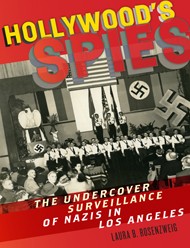In Hitler in Los Angeles: How Jews Foiled Nazi Plots Against Hollywood and America, historian Steven J. Ross reminds us how vulnerable American Jews were to the propaganda that emanated from Nazi Germany. Joseph Goebbels’s propaganda network continually promoted the idea that American Jews were determined to push the United States into a war with Nazi Germany. But it wasn’t only groups conceived by the Nazis in Germany, such as the Friends of New Germany and the German American Bund, who agitated against Jews; there were also native anti-Semitic groups such as Pelley’s Silver Shirts. Anti-Jewish bigotry could even be found in the halls of Congress, where Theodore Bilbo, John Rankin, Martin Dies, and Louis McFadden, among others, openly spewed their hatred of Jews.
Ross’s book focuses on the activities of Leon Lewis, an attorney and communal leader who led the fight against the Nazis in 1930s Los Angeles. Earlier than most, Lewis saw the danger to American Jews from the growth of pro-Nazi groups like the Friends of New Germany. He was surprised at the indifference of law enforcement agencies like the FBI — who preferred to monitor Reds rather than Nazis. But in fact, In Los Angeles many police officers were anti-Semitic; a number of them were supporters of the Klan. To publicize the threat of these Nazi and fascist groups, Lewis, later joined by fellow activist Joseph Roos, recruited a ring of spies to infiltrate the Nazi network in L.A. His success in providing information to law enforcement agencies thwarted the sabotaging efforts of the Nazis in Navy shipyards and military bases, as well as an assassination plot directed toward Jews in the entertainment industry. Lewis and Roos’s success in awakening law enforcement to the Nazi threat — including the J. Edgar Hoover-led FBI — caused the Nazi leadership to label Lewis “the most dangerous Jew in Los Angeles.”
Ross has written a riveting book that will enlighten readers as to how susceptible American Jews were to the spread of anti-Semitism on the eve of World War II.



